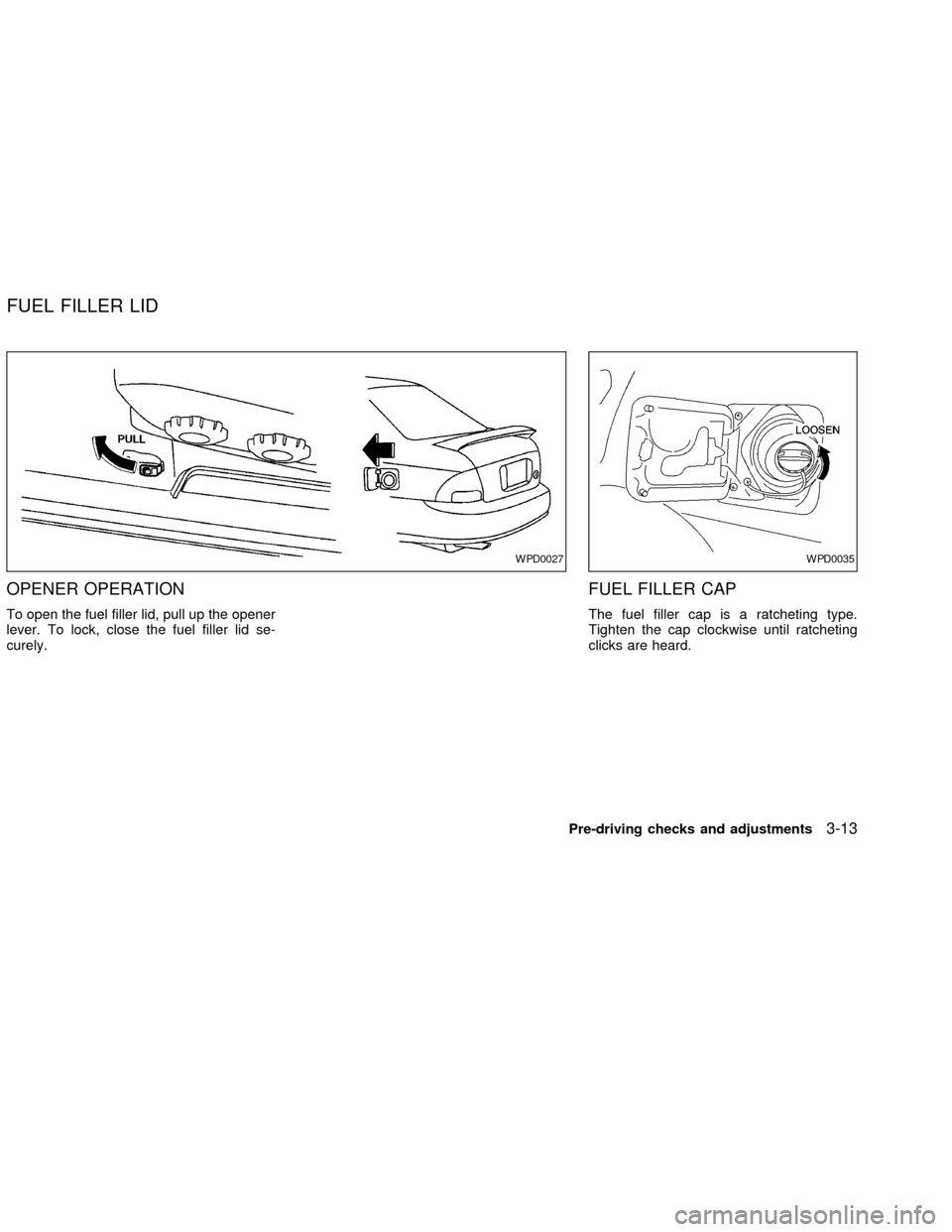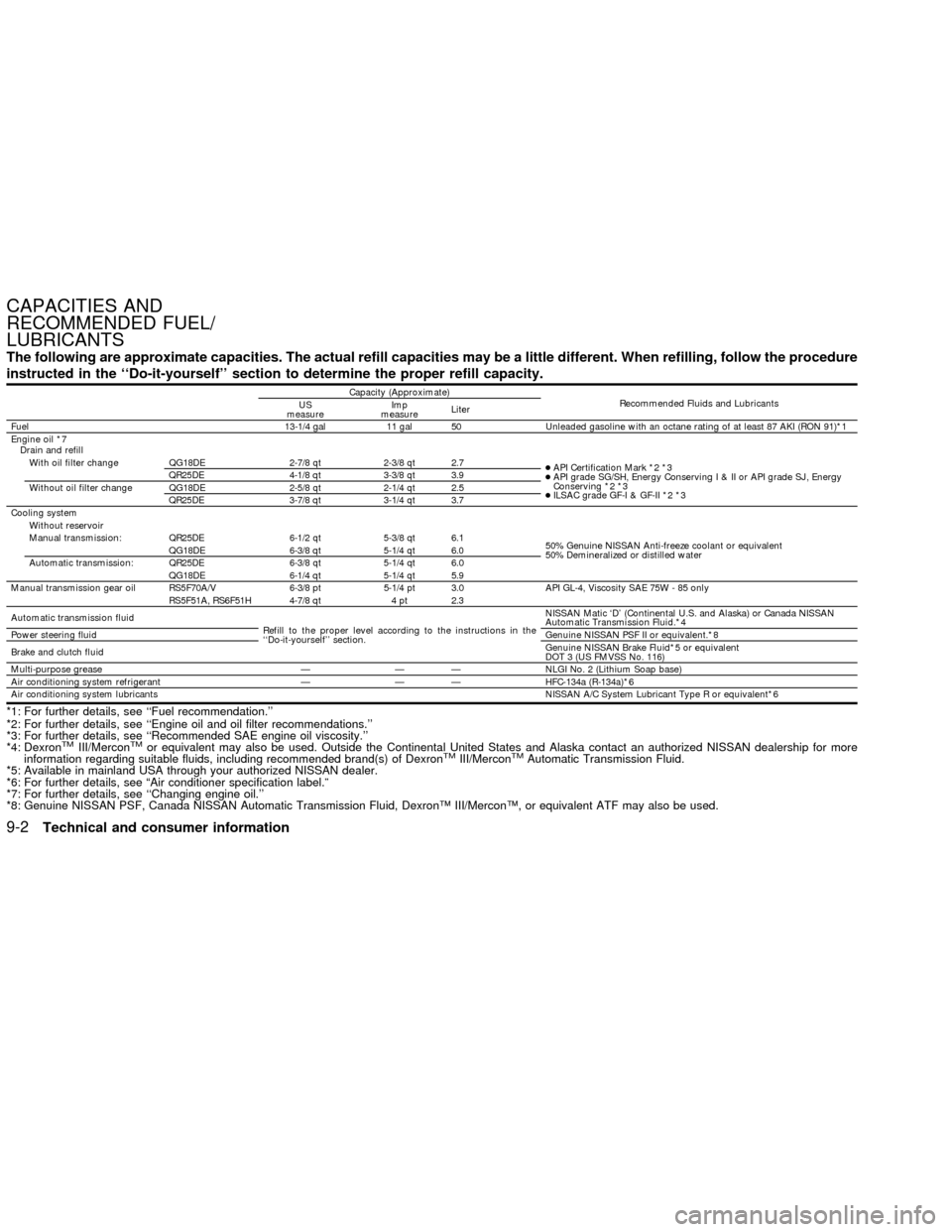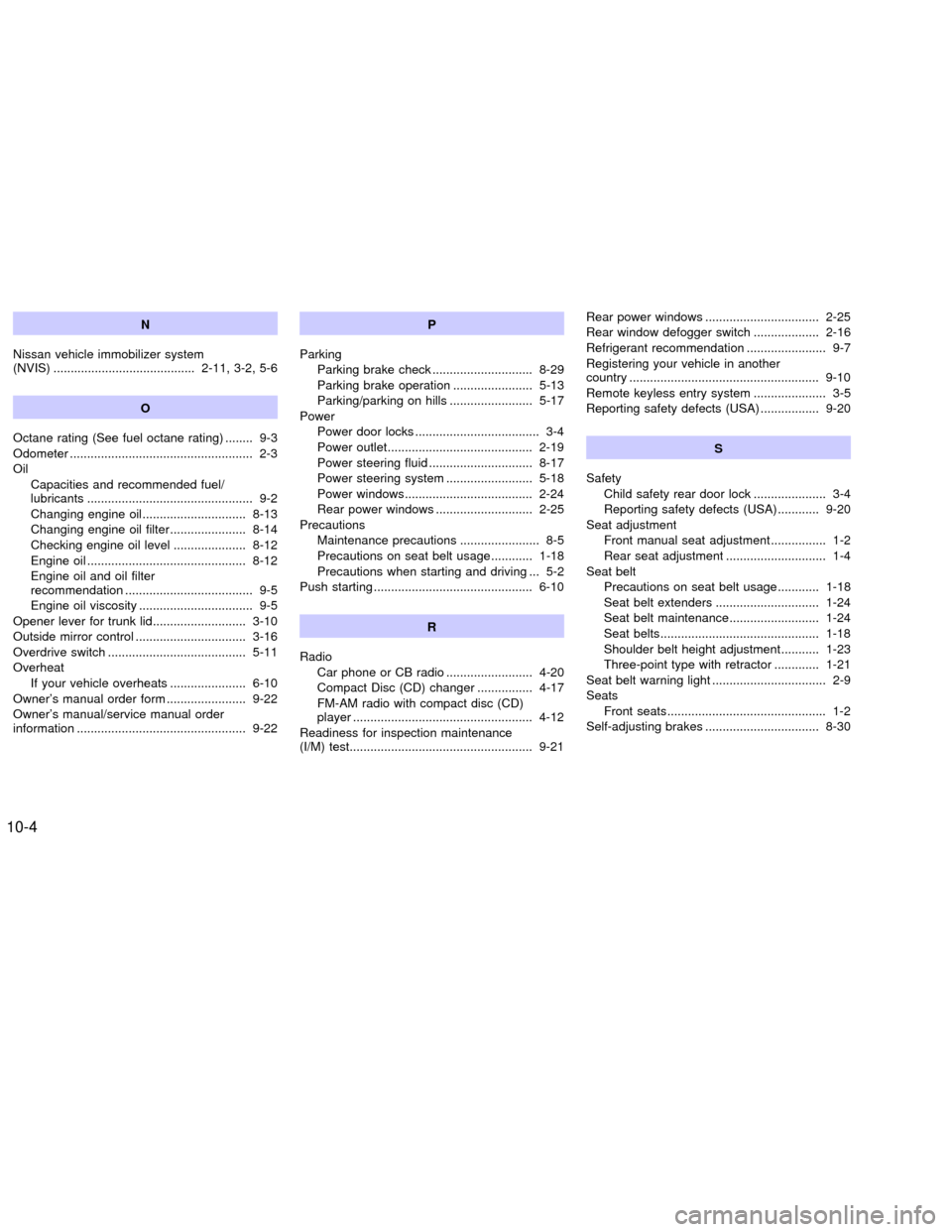2002 NISSAN SENTRA fuel type
[x] Cancel search: fuel typePage 47 of 235

1. Headlight and turn signal switch
2. Meters/gauges
3. Windshield wiper/washer switch
4. Heater/air conditioner control
5. Storage compartment
6. Hazard warning flasher switch
7. Center ventilators
8. Passenger supplemental air bag
9. Glove box
10. Ashtray
11. 12 volt DC/cigarette lighter (accessory)
12. 12 volt DC/cigarette lighter (accessory)
(if so equipped)
13. Radio/CD player/CD changer
14. Cruise control and main set switch
15. Tilt steering lock lever
16. Trunk release Type B
17. Fuel filler lid opening lever
18. Driver supplemental air bag
19. Hood release lever
20. Fuse box cover/coin holder
21. Trunk release Type A
22. Instrument brightness control switch
23. Outside mirror control switch
WIC0151
INSTRUMENT PANEL
2-2Instruments and controls
ZX
Page 86 of 235

OPENER OPERATION
To open the fuel filler lid, pull up the opener
lever. To lock, close the fuel filler lid se-
curely.
FUEL FILLER CAP
The fuel filler cap is a ratcheting type.
Tighten the cap clockwise until ratcheting
clicks are heard.
WPD0027WPD0035
FUEL FILLER LID
Pre-driving checks and adjustments3-13
ZX
Page 87 of 235

WARNING
c
Gasoline is extremely flammable and
highly explosive under certain condi-
tions. You could be burned or seriously
injured if it is misused or mishandled.
Always stop the engine and do not
smoke or allow open flames or sparks
near the vehicle when refueling.
cFuel may be under pressure. Turn the
cap one-half turn and wait for any ``hiss-
ing'' sound to stop to prevent fuel from
spraying out and possibly causing per-
sonal injury. Then remove the cap.
cDo not attempt to top off the fuel
tank after the fuel pump nozzle shuts
off automatically. Continued refuel-
ing may cause fuel overflow, result-
ing in fuel spray and possibly fire.
cUse only an original equipment type
fuel filler cap as a replacement. It has
a built-in safety valve needed for
proper operation of the fuel system
and emission control system. An in-
correct cap can result in a serious
malfunction and possible injury. It
could also cause the malfunction
indicator lamp to come on.Do not fill a portable fuel container in
the vehicle or trailer. Static electric-
ity can cause an explosion of flam-
mable liquid, vapor or gas in any
vehicle or trailer. To reduce the risk
of serious injury or death when fill-
ing portable fuel containers:
Ð Always place the container on
the ground when filling.
Ð Do not use electronic devices
while filling.
Ð Keep the pump nozzle in contact
with the container while you are
filling it.
Ð Use only approved portable fuel
containers for flammable liquid.
cNever pour fuel into the throttle body
to attempt to start your vehicle.
CAUTION
cIf fuel is spilled on the vehicle body,
flush it away with water to avoid
paint damage.cTighten until the fuel filler cap clicks.
Failure to tighten the fuel filler cap
properly may cause the
mal-
function indicator lamp (MIL) to illu-
minate. If the
lamp illuminates
because the fuel filler cap is loose or
missing, tighten or install the cap
and continue to drive the vehicle.
The
lamp should turn off after a
few driving trips. If thelamp
does not turn off after a few driving
trips, have the vehicle inspected by
an authorized NISSAN dealer.
cFor additional information, see the
``Malfunction indicator lamp (MIL)''
in the ``Instruments and controls''
section earlier in this manual.
3-14Pre-driving checks and adjustments
ZX
Page 205 of 235

The following are approximate capacities. The actual refill capacities may be a little different. When refilling, follow the procedure
instructed in the ``Do-it-yourself'' section to determine the proper refill capacity.
Capacity (Approximate)
Recommended Fluids and Lubricants
US
measureImp
measureLiter
Fuel 13-1/4 gal 11 gal 50 Unleaded gasoline with an octane rating of at least 87 AKI (RON 91)*1
Engine oil *7
Drain and refill
With oil filter change QG18DE 2-7/8 qt 2-3/8 qt 2.7
cAPI Certification Mark *2 *3
cAPI grade SG/SH, Energy ConservingI&IIorAPIgrade SJ, Energy
Conserving *2 *3
cILSAC grade GF-I & GF-II *2 *3 QR25DE 4-1/8 qt 3-3/8 qt 3.9
Without oil filter change QG18DE 2-5/8 qt 2-1/4 qt 2.5
QR25DE 3-7/8 qt 3-1/4 qt 3.7
Cooling system
Without reservoir
50% Genuine NISSAN Anti-freeze coolant or equivalent
50% Demineralized or distilled water Manual transmission: QR25DE 6-1/2 qt 5-3/8 qt 6.1
QG18DE 6-3/8 qt 5-1/4 qt 6.0
Automatic transmission: QR25DE 6-3/8 qt 5-1/4 qt 6.0
QG18DE 6-1/4 qt 5-1/4 qt 5.9
Manual transmission gear oil RS5F70A/V 6-3/8 pt 5-1/4 pt 3.0 API GL-4, Viscosity SAE 75W - 85 only
RS5F51A, RS6F51H 4-7/8 qt 4 pt 2.3
Automatic transmission fluid
Refill to the proper level according to the instructions in the
``Do-it-yourself'' section.NISSAN Matic `D' (Continental U.S. and Alaska) or Canada NISSAN
Automatic Transmission Fluid.*4
Power steering fluidGenuine NISSAN PSF II or equivalent.*8
Brake and clutch fluidGenuine NISSAN Brake Fluid*5 or equivalent
DOT 3 (US FMVSS No. 116)
Multi-purpose grease Ð Ð Ð NLGI No. 2 (Lithium Soap base)
Air conditioning system refrigerant Ð Ð Ð HFC-134a (R-134a)*6
Air conditioning system lubricantsNISSAN A/C System Lubricant Type R or equivalent*6
*1: For further details, see ``Fuel recommendation.''
*2: For further details, see ``Engine oil and oil filter recommendations.''
*3: For further details, see ``Recommended SAE engine oil viscosity.''
*4: Dexron
TMIII/MerconTMor equivalent may also be used. Outside the Continental United States and Alaska contact an authorized NISSAN dealership for more
information regarding suitable fluids, including recommended brand(s) of DexronTMIII/MerconTMAutomatic Transmission Fluid.
*5: Available in mainland USA through your authorized NISSAN dealer.
*6: For further details, see ªAir conditioner specification label.º
*7: For further details, see ``Changing engine oil.''
*8: Genuine NISSAN PSF, Canada NISSAN Automatic Transmission Fluid, DexronŸ III/MerconŸ, or equivalent ATF may also be used.
CAPACITIES AND
RECOMMENDED FUEL/
LUBRICANTS
9-2Technical and consumer information
ZX
Page 208 of 235

ENGINE OIL AND OIL FILTER
RECOMMENDATION
Selecting the correct oil
It is essential to choose engine oil with the
correct quality and viscosity to ensure sat-
isfactory engine life and performance. NIS-
SAN recommends the use of a low friction
oil (energy conserving oil) in order to im-
prove fuel economy and conserve energy.
Oils which do not have the specified quality
label should not be used as they could
cause engine damage.
Only those engine oils with the AmericanPetroleum Institute (API) CERTIFICATION
MARK on the front of the container should
be used. This type of oil supersedes the
existing API SG, SH, or SJ and Energy
ConservingI&IIcategories.
If you cannot find engine oil with the API
CERTIFICATION MARK, use an API grade
SG/SH, Energy ConservingI&IIorAPI
grade SJ, Energy Conserving oil. An oil with
a single designation SG or SH, or in combi-
nation with other categories (for example,
SG/CC or SG/CD) may also be used if one
with the API CERTIFICATION MARK can-
not be found. An ILSAC grade GF-I & GF-II
oil can also be used.Mineral based or synthetic type oils may be
used in your NISSAN vehicle. However,
these oils must meet the API quality and
SAE viscosity ratings specified for your ve-
hicle. Do not mix mineral based and syn-
thetic type oils in the engine.
Oil additives
NISSAN does not recommend the use of oil
additives. The use of an oil additive is not
necessary when the proper oil type is used
and maintenance intervals are followed.
Oil which may contain foreign matter or has
been previously used should not be used.
Oil viscosity
The engine oil viscosity or thickness
changes with temperature. Because of this,
it is important to select the engine oil viscos-
ity based on the temperatures at which the
vehicle will be operated before the next oil
change. The chart ``Recommended SAE
viscosity number'' shows the recommended
oil viscosities for the expected ambient tem-
peratures. Choosing an oil viscosity other
than that recommended could cause seri-
ous engine damage.
WTI0033
Technical and consumer information9-5
ZX
Page 231 of 235

N
Nissan vehicle immobilizer system
(NVIS) ......................................... 2-11, 3-2, 5-6
O
Octane rating (See fuel octane rating) ........ 9-3
Odometer ..................................................... 2-3
Oil
Capacities and recommended fuel/
lubricants ................................................ 9-2
Changing engine oil.............................. 8-13
Changing engine oil filter...................... 8-14
Checking engine oil level ..................... 8-12
Engine oil .............................................. 8-12
Engine oil and oil filter
recommendation ..................................... 9-5
Engine oil viscosity ................................. 9-5
Opener lever for trunk lid........................... 3-10
Outside mirror control ................................ 3-16
Overdrive switch ........................................ 5-11
Overheat
If your vehicle overheats ...................... 6-10
Owner's manual order form ....................... 9-22
Owner's manual/service manual order
information ................................................. 9-22P
Parking
Parking brake check ............................. 8-29
Parking brake operation ....................... 5-13
Parking/parking on hills ........................ 5-17
Power
Power door locks .................................... 3-4
Power outlet.......................................... 2-19
Power steering fluid .............................. 8-17
Power steering system ......................... 5-18
Power windows..................................... 2-24
Rear power windows ............................ 2-25
Precautions
Maintenance precautions ....................... 8-5
Precautions on seat belt usage............ 1-18
Precautions when starting and driving ... 5-2
Push starting .............................................. 6-10
R
Radio
Car phone or CB radio ......................... 4-20
Compact Disc (CD) changer ................ 4-17
FM-AM radio with compact disc (CD)
player .................................................... 4-12
Readiness for inspection maintenance
(I/M) test..................................................... 9-21Rear power windows ................................. 2-25
Rear window defogger switch ................... 2-16
Refrigerant recommendation ....................... 9-7
Registering your vehicle in another
country ....................................................... 9-10
Remote keyless entry system ..................... 3-5
Reporting safety defects (USA) ................. 9-20
S
Safety
Child safety rear door lock ..................... 3-4
Reporting safety defects (USA) ............ 9-20
Seat adjustment
Front manual seat adjustment................ 1-2
Rear seat adjustment ............................. 1-4
Seat belt
Precautions on seat belt usage............ 1-18
Seat belt extenders .............................. 1-24
Seat belt maintenance.......................... 1-24
Seat belts.............................................. 1-18
Shoulder belt height adjustment ........... 1-23
Three-point type with retractor ............. 1-21
Seat belt warning light ................................. 2-9
Seats
Front seats.............................................. 1-2
Self-adjusting brakes ................................. 8-30
10-4
ZX